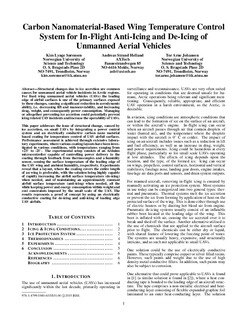| dc.description.abstract | Structural changes due to ice accretion are common causes for unmanned aerial vehicle incidents in Arctic regions. For fixed wing unmanned aerial vehicles (UAVs) the leading edge of airfoil surfaces is one of the primary surfaces exposed to these changes, causing a significant reduction in aerodynamic ability, i.e. decreasing lift and manoeuvrability, and increasing drag, weight, and consequently power consumption. Managing or altogether preventing ice accretion could potentially prevent icing related UAV incidents and increase the operability of UAVs. This paper addresses the issue of structural change, caused by ice accretion, on small UAVs by integrating a power control system and an electrically conductive carbon nano material based coating for temperature control of UAV airfoil surfaces. Performance assessment is achieved through extensive laboratory experiments, where various coating layouts have been investigated in various conditions, with temperatures ranging from +25° to -25°. The experimental setup consists of an Arduino microcontroller capable of controlling power delivery to the coating through feedback from thermocouples and a humidity sensor, sensing the surface temperature of the leading edge of the UAV wing and ambient humidity, respectively. Experiments reveal that a layout, where the coating covers the entire length of an wing is preferable, with the solution being highly capable of rapidly increasing the airfoil surface temperature (de-icing) when needed, and of maintaining an approximately constant airfoil surface temperature (anti-icing) when needed, all the while keeping power and energy consumption within weight and cost constraints imposed by the small scale of the UAV. The results represents a proof of concept by using an electrically conductive coating for de-icing and anti-icing of leading edge UAV airfoils | nb_NO |
